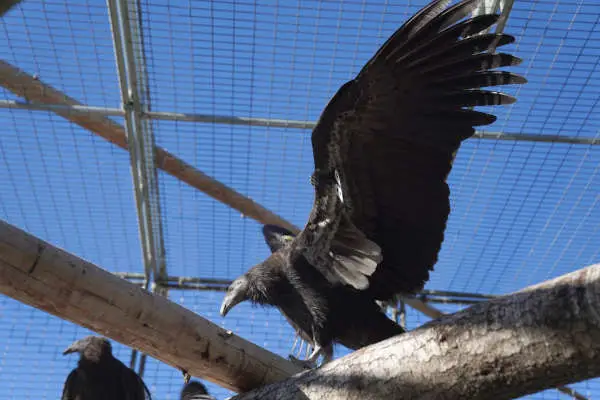
The Northern California Condor Restoration Program, or NCCRP, will attempt to release three prey-go-neesh, or California condors, into Yurok ancestral territory at approximately 8 a.m. on Wednesday, Nov. 8.
After assessing each of the new condors, NCCRP biologists deemed that all are ready for release.
NCCRP biologists will wait for previously released prey-go-neesh to be present and feeding at the condor management facility before initiating the release of the young condors.
The proximity to free-flying prey-go-neesh will signal to the new birds that it is safe to leave the secure flight pen.
The release attempt can be viewed live here.
For the initial release of new condors, the NCCRP utilizes a “soft” approach. The program intends to open the flight pen to give the three birds and a mentor from the first cohort the opportunity to leave the facility at their own pace.
“We always hope the birds will immediately depart the flight pen, but it is out of our control. After we open the gate, we are on condor time,” said NCCRP Manager and Yurok Wildlife Department Senior Biologist Chris West. “If the birds remain in the flight pen for several hours, we will reevaluate and possibly reinitiate the process on another day.”
On Oct. 9, the NCCRP received the three approximately year and a half old condors from the Los Angeles Zoo.
The two females and one male, include, 1140, wing tag B0 (female); 1148, wing tag B1(male); and 1151, wing tag B2 (female).
The three prey-go-neesh were hatched and reared at the Los Angeles Zoo. At the zoo, the birds were also vaccinated against Highly Pathogenic Avian Influenza, or HPAI. They will be the first condors vaccinated for HPAI to be released into the wild.
Condors are extremely social animals. During the last month, the new condors have been regularly visited by free-flying birds, laying the groundwork for their integration into the population.
NCCRP biologists expect the eight free-flying birds to aid the new condor cohort in getting acquainted with their new environment.
Last year, the NCCRP, a partnership between the Yurok Tribe and Redwood National and State Parks, released the first eight condors to fly over far Northern California in more than a century.
Overall, the birds are doing very well in their new home. The birds are exhibiting positive behaviors, such as eating, soaring and resting in protected roosts.
They have explored much of Humboldt and Del Norte Counties, including excursions as far south as Hyampom and as far north as the Notchko area on the Yurok Reservation.
To date, the longest distance traveled from the release site is 52 miles.
Yurok connection to the condor
The restoration of this sacred species reflects the Yurok Tribe’s cultural obligation to maintain balance in the world.
It is also a component of the tribe’s plan to restore as much fish and wildlife habitat as possible in Yurok ancestral territory.
The tribe’s terrestrial territory extends from Damnation Creek in Del Norte County to the Little River in Humboldt County on the coast and heads up the Klamath River for 44 miles from the ocean to the confluence with the Trinity River.
In addition to the reintroduction of the critically endangered condor, the tribe is currently rebuilding fish and wildlife habitat on significant portions of the Klamath River, Sacramento River and Prairie Creek as well as other Klamath tributaries.
The tribe is also integrally involved in the ongoing removal of the four Klamath dams, which represents the most ambitious salmon habitat restoration project in US history. The removal of the dams will also benefit many other fish and wildlife species, including condors.
The Yurok Tribe initiated the condor reintroduction project in 2008 with funding support from the Bureau of Indian Affairs, the U.S. Fish and Wildlife Service, and Redwood National Park, as well as the Administration for Native Americans, Pacific Gas and Electric Company, Global Conservation Fund, the National Park Foundation, and many more corporate, agency, and private supporters and citizens.
The Yurok Wildlife Department performed an immense amount of work to prepare for the reintroduction of this imperiled species.